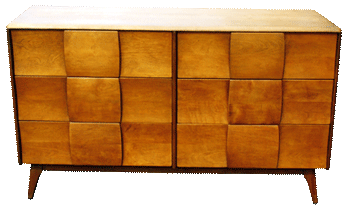- A fresh start
- Guest Editor’s Column
- Cast in Bronze
- The month that was
- Visual Diary
- Nomadic Detours
- Relation Next
- Lightness of being Anxious
- Necklace of Echoes
- The New Order Beauty
- Voyage
- Ribbed Routes
- Museum Talk
- Hard Talk
- Master Stroke
- Market Insight
- Artist Index and Statistics
- Auction Reports
- Creative Impulse
- Mid Century Modern : Retro Furniture
- 14th Kolkata Film Festival
- ABOHOMAN
- In the News
- Photo Feature
- Different hues of Aakriti
ART news & views
Mid Century Modern : Retro Furniture
Volume: 2 Issue No: 1 Month: 2 Year: 2010
'Mid-century furniture' is a term usually applied to a furniture style developed in the early 20th century but that was adapted and gained worldwide attention after World War II. Also referred to as Modern Furniture, the most celebrated of mid-century furniture styles was a simple design option known as - Danish modern. Mid-Century modern is an architectural, interior and product design form that generally describes mid-20th century developments in modern design,  architecture, and urban development from roughly 1933 to 1965.
architecture, and urban development from roughly 1933 to 1965.
This style is now recognized by scholars and museums worldwide as a significant design movement. Scandinavian designers and architects were very influential at this time, with a style characterized by simplicity, democratic design and natural shapes.
World War II brought about changes in the basic design, due to shortage of materials. The newer designs of modern furniture made use of whatever types of wood and other products were available. A result of this thrifty use of various elements was the creation of the mid-century furniture design that would come to be known as Danish modern.
The clean lines of this modern furniture were created using various types of wood. Oak, birch and even teak furniture were created in this style. The coloring usually remained bleached or blonde, drawing a clear distinction from the dark woods common before the War. For upholstery on the thin pads for the back and seat cushions, materials such as light colored linens, new heavy duty vinyl and even bleached leather were used.
The dramatic relevance of mid-century modern design continues to take a foremost role in today's design inspiration. While there are many furniture pieces that claim to be “mid-century modern,” there are several defining characteristics that capture the essence of this era of modernism.
The lovely lines: The most outstanding feature of mid-century Modern Furniture is the clean, lovely lines. As a sharp contrast to the furniture that pre-dated the 1950s, mid-century modern designers found beauty in lines that were sleek, uncluttered, and clean.  Smooth lines epitomized the modernity these designers wished to emulate. Mid-century modern furniture is easily spotted by its streamlined appearance.
Smooth lines epitomized the modernity these designers wished to emulate. Mid-century modern furniture is easily spotted by its streamlined appearance.
Prevalence of teak: Along with the infusion of man-made materials, including fiber glass was a tremendous affection for teak wood in mid-century modern design. With the large Danish influence on modernism, the wood's warmth and strength was embraced by a WWII-tattered world looking to find serenity. In addition, from a design perspective, teak provided an excellent backdrop and accent to the interesting colors and textures.
Colors and textures: Bursting onto the scenes of mid-century modern inspiration was a plethora of unique textures and colors. By emphasizing the contemporary outlook of the home, mid-century modern design wanted to forget the past, but rather emphasize the hope (of a peaceful world) that the future held.
Use of cutting-edge materials (at least, for that era): Turning the traditional woods on its head, mid-century modern design introduced the mass appeal of man-made materials that were not previously found in furniture. Plastic becomes an important element of mid-century modern furniture, including Bakelite on table tops, along with Plexiglas and Lucite. A classic example of the use of nontraditional materials is Eames' Low arm chair made of fiberglass, as well as the tulip armchair by Saarinen.